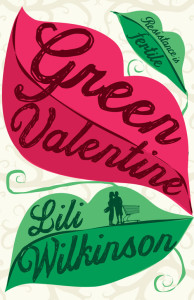Allen & Unwin, RRP $16.99
August 2015
Green Valentine is a beam of sunshine through the dark cloud of cynicism. Let’s face it; fiction these days, and in particular young adult fiction, can be pretty bleak. There’s The Hunger Games, where a totalitarian region maintains order through fear by forcing children to slaughter each other. The Harry Potter series, known for its quirky humour, also straddles dark territory with beloved characters dying during the terror of war. These are poignant stories which allow the reader to ride waves of emotion; fear, anger, sadness; and feel just that little bit more alive, to exist wholly in the moment. But when the worlds we read are always dark they can shape our perception until, perhaps, we then see only darkness in our own world.
So in the landscape of distrust that real life is becoming, perhaps we owe it to ourselves to find stories that celebrate the joy and excitement of life, to surround ourselves by inspiration rather than despair. Which brings us back to Green Valentine. Lili Wilkinson has written an unapologetically optimistic story of finding love, learning acceptance and changing the world, one strawberry at a time, and it’s like a warm shower after a week’s worth of camping in the rain. It could possibly even be the sweetest story ever written.
Astrid Katy Smythe is the epitome of high school popularity, both beautiful and smart, but rather than using her status for evil, she advocates, doggedly, for environmental protection. Not that it does much good. No one seems to be listening in the concrete cornucopia of Valentine. Except that one day, while dressed as a lobster, she makes a connection with the cute boy who collects the shopping trolleys. Hiro is a high school misfit who is more interested in pranks than positive change. But he understands that the world is broken, full of people with their eyes closed. The two gravitate to each other and soon find love, rebellion and many, many vegetables.
Green Valentine is part romance and part extreme gardening guide. The two leads revel both in dirt and in each other. We can imagine the earthy rich scent of soil, and perhaps the slightly ripe smell of manure, mixing with perspiration, and it’s more electrically charged than any moody vampire. It’s that moment of first love, in all its earnestness, that allows Astrid and Hiro to see from perspectives that aren’t their own, away from the pressures of social expectation, and so become more like themselves (or perhaps truer versions of their superhero selves).
In a way, Astrid and Hiro represent dual conflicts of idealism. On one hand, Astrid is our optimistic self, utterly convinced in the goodness of the world and the possibility, even inevitability, of change. On the other hand, Hiro is the demon on our shoulder, the pessimistic self, who can only see the bad of the world, the stagnation of the generations that came before us, and the powerlessness we currently possess. Each wants to impact the world, but disagree on the how. One wants change; the other wants disruption. It’s an internal struggle that can inflict anyone who feels passionate about social or political change.
Ultimately, Green Valentine is Astrid’s story, and optimism is our guiding star. We feel her need to leave the world better than it was before, and that hope becomes infectious. We want to make the world a better place as well. After reading this book you might find yourself with an irresistible urge to plant cucumbers all over your suburb. And this we can only encourage.


